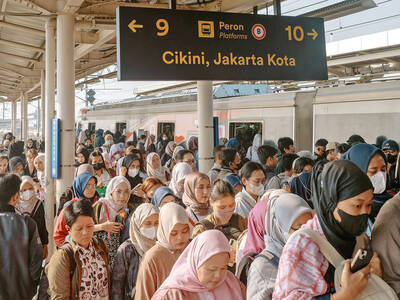Cheap and illicit alcohol kills more than half of all Russian men and women in their most productive years and the government must act to reverse the trend, a study to be published in The Lancet at the weekend said.
“Excessive alcohol consumption in Russia, particularly by men, has in several recent years caused more than half of all the deaths at ages of 15-54 years,” The Lancet said.
The research conducted in three industrial cities — Tomsk, Barnaul and Biysk — said “excess mortality from liver cancer, throat cancer, liver disease and pancreatic disease is largely or wholly because alcohol caused the disease that caused death.”
High mortality from tuberculosis and pneumonia may be partly a result of increased exposure to infection, weak immunity, or decreased likelihood of cure, the research found.
Russia’s mortality rate in people aged 15 to 54 was more than five times higher for men and three times higher for women than in Western Europe, the study showed.
Alcohol is responsible for about three-quarters of the deaths of all Russian men aged 15 to 54 and about half of all deaths of Russian women of the same age, the data showed.
Russia must stop or tax the illicit alcohol output, the article said, adding that this in turn would mean “confrontation with organized criminals and corrupt officials ... All that is needed is the political will to make public health a priority.”
“Each year 1.3 million people die from cardio-vascular diseases in Russia,” said David Zaridze, head of the Russian Cancer Research Center and principal author of the study.
“Based on our investigation, it is possible to suggest that at least a third of these deaths is linked to alcohol consumption and not to any specific heart pathology,” he said.
Alcohol-related deaths also include suicides, murders, drowning and deaths in fires, he said.
A UN report in April said that poor diet, leading to heart disease, heavy drinking and the high incidence of violent deaths may cut Russia’s present population of some 142 million to around 131 million by 2025.
Store shelves across Russia are laden with cheap vodka that costs between 60 rubles (US$1.92) and 80 rubles per half liter bottle, while Russia’s illicit alcohol production is estimated to account for at least 50 percent of consumption.
Alexander Nemtsov, a department chief at the Moscow Research Institute of Psychiatry, estimated Russia’s annual consumption at 15 liters of pure alcohol per capita, including children and elderly people. This compares with just 6 liters in 1864, he said.
He estimated Russia had some 2.5 million registered alcoholics and about the same number of unregistered ones.
“Drunkards, not alcoholics, are the main threat to demography,” Nemtsov said. “Heavy drinkers make up 40 percent of Russian males, but this figure may be bigger.”
The proportion of male and female drinkers is 4 to 1, he said.
Approximately 30,000 people — twice the number the Soviet Union lost during its 10-year war in Afghanistan — die from alcohol poisoning in Russia each year.
Psychiatrist Nemtsov said fighting drinking in Russia was an uphill task, because cheap vodka was only part of the problem.

STEPPING UP: Diminished US polar science presence mean opportunities for the UK and other countries, although China or Russia might also fill that gap, a researcher said The UK’s flagship polar research vessel is to head to Antarctica next week to help advance dozens of climate change-linked science projects, as Western nations spearhead studies there while the US withdraws. The RRS Sir David Attenborough, a state-of-the-art ship named after the renowned British naturalist, would aid research on everything from “hunting underwater tsunamis” to tracking glacier melt and whale populations. Operated by the British Antarctic Survey (BAS), the country’s polar research institute, the 15,000-tonne icebreaker — boasting a helipad, and various laboratories and gadgetry — is pivotal to the UK’s efforts to assess climate change’s impact there. “The saying goes

FRUSTRATIONS: One in seven youths in China and Indonesia are unemployed, and many in the region are stuck in low-productivity jobs, the World Bank said Young people across Asia are struggling to find good jobs, with many stuck in low-productivity work that the World Bank said could strain social stability as frustrations fuel a global wave of youth-led protests. The bank highlighted a persistent gap between younger and more experienced workers across several Asian economies in a regional economic update released yesterday, noting that one in seven young people in China and Indonesia are unemployed. The share of people now vulnerable to falling into poverty is now larger than the middle class in most countries, it said. “The employment rate is generally high, but the young struggle to

ENERGY SHIFT: A report by Ember suggests it is possible for the world to wean off polluting sources of power, such as coal and gas, even as demand for electricity surges Worldwide solar and wind power generation has outpaced electricity demand this year, and for the first time on record, renewable energies combined generated more power than coal, a new analysis said. Global solar generation grew by a record 31 percent in the first half of the year, while wind generation grew 7.7 percent, according to the report by the energy think tank Ember, which was released after midnight yesterday. Solar and wind generation combined grew by more than 400 terawatt hours, which was more than the increase in overall global demand during the same period, it said. The findings suggest it is

FIRST STAGE: Hamas has agreed to release 48 Israeli hostages in exchange for 250 ‘national security prisoners’ as well as 1,700 Gazans, but has resisted calls to disarm Israel plans to destroy what remains of Hamas’ network of tunnels under Gaza, working with US approval after its hostages are freed, it said yesterday. Israeli Minister of Defense Israel Katz said that the operation would be conducted under an “international mechanism” led by the US. “Israel’s great challenge after the hostage release phase will be the destruction of all Hamas terrorist tunnels in Gaza,” Katz said. “I have ordered the army to prepare to carry out this mission,” he added. Hamas operates a network of tunnels under Gaza, allowing its fighters to operate out of sight of Israeli reconnaissance. Some have passed under